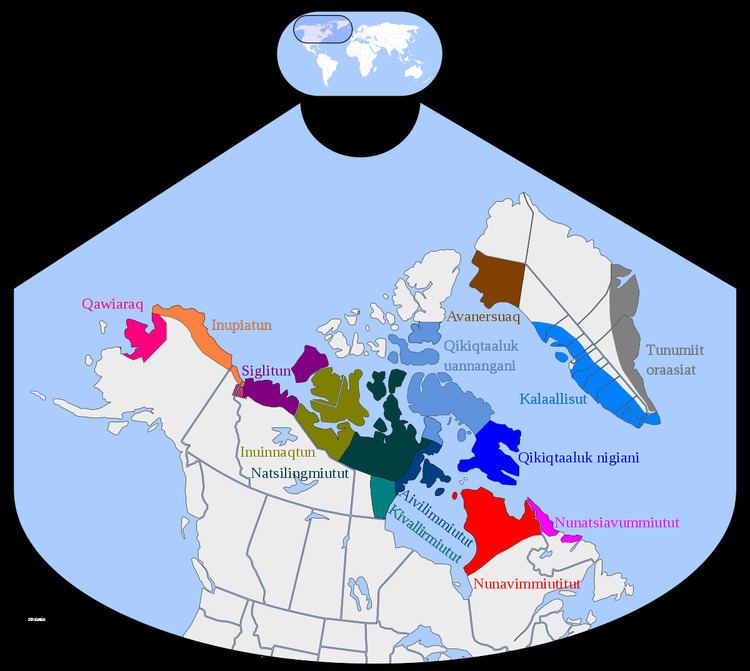Native to Canada | Ethnicity Inuvialuit | |
 | ||
Native speakers 630 (2011 census; NWT only?) Language family Eskimo–AleutEskimoInuitInuvialuktun Dialects NatsilingmiututInuinnaqtunSiglitun | ||
Inuvialuktun, also known as Western Canadian Inuit, Western Canadian Inuktitut, and Western Canadian Inuktun, comprises several Inuit language varieties spoken in the northern Northwest Territories and Nunavut by those Canadian Inuit who call themselves Inuvialuit.
Contents
Inuvialuktun is spoken by the Inuit of the Mackenzie River delta, Banks Island, part of Victoria Island and the Arctic Ocean coast of the Northwest Territories – the lands of the Inuvialuit Settlement Region. It was traditionally subsumed under a broader Inuktitut, and there is no consensus which dialects belong to which language. Rather than a coherent language, Inuvialuktun is a politically motivated grouping of three quite distinct and separate varieties.
Inuvialuktun (which consists of Siglitun (Inuvialuktun proper), Inuinnaqtun and Natsilingmiutut) and Inuinnaqtun constitute two of the eleven official languages of the Northwest Territories. Inuinnaqtun is also official alongside Inuktitut in Nunavut. With the exception of Natsilingmiutut they are written in a Latin alphabet and have no tradition of Inuktitut syllabics.
Before the 20th century, the Inuvialuit Settlement Region was primarily inhabited by Siglit Inuit, who spoke Siglitun, but in the second half of the 19th century, their numbers were dramatically reduced by the introduction of new diseases. Inuit from Alaska moved into traditionally Siglit areas in the 1910s and 1920s, enticed in part by renewed demand for furs from the Hudson's Bay Company. These Inuit are called Uummarmiut – which means people of the green trees – in reference to their settlements near the tree line. Originally, there was an intense dislike between the Siglit and the Uummarmiut, but these differences have faded over the years, and the two communities are thoroughly intermixed these days.
Dialects
The Inuvialuktun dialects are seriously endangered, as English has in recent years become the common language of the community. Surveys of Inuktitut usage in the NWT vary, but all agree that usage is not vigorous. According to the Inuvialuit Cultural Resource Centre, only some 10% of the roughly 4,000 Inuvialuit speak any form of Inuktitut, and only some 4% use it at home. Statistics Canada's 2001 Census report is only slightly better, reporting 765 self-identified Inuktitut speakers out of a self-reported Inuvialuit population of 3,905. Considering the large number of non-Inuit living in Inuvialuit areas and the lack of a single common dialect among the already reduced number of speakers, the future of the Inuit language in the NWT appears bleak.
From east to west, the dialects are:
The Inuvialuk dialects spoken in Nunavut (that is, Iglulingmiut, Aivilingmiutut, Kivallirmiutut, and eastern Natsilingmiutut) are often counted as Inuktitut, and the government of the NWT only recognizes Inuinnaqtun and Inuvialuktun. In addition, Uummarmiutun, the dialect of the Uummarmiut which is essentially identical to the Inupiatun dialect spoken in Alaska and so considered an Inupiat language, has conventionally been grouped with Inuvialuktun because it's spoken in the Inuvialuit Settlement Region of the NWT. Uummarmiutun is found in the communities of Inuvik and Aklavik.
Preservation
English has in recent years become the common language of the Inuvialuit. Surveys of Inuktitut usage in the NWT vary, but all agree that usage is not vigorous. According to the Inuvialuit Cultural Resource Centre, only some 10% of the roughly 4,000 Inuvialuit speak any dialect of Inuvialuktun, and only some 4% use it at home. Statistics Canada's 2001 Census reports 765 self-identified Inuvialuktun speakers out of a self-reported Inuvialuit population of 3,905.
